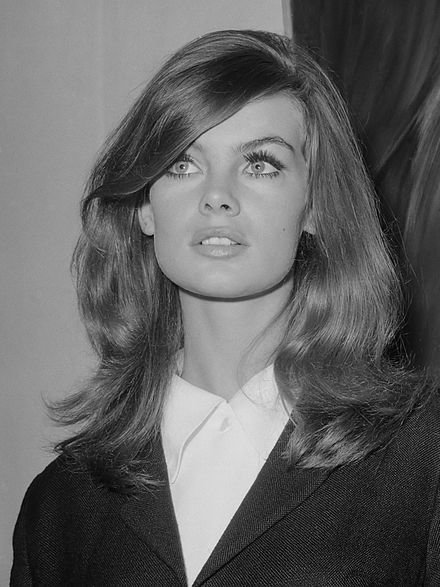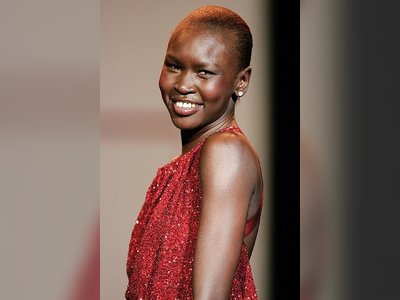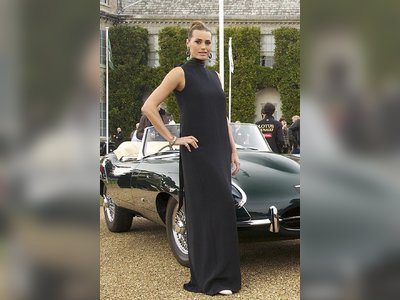British Heritage
Remember, Cherish, Learn.
beta
Jean Shrimpton

A Supermodel Shaping Britain's Cultural and Fashion Heritage.
Emerging amidst the transformative era of Swinging London, Jean Rosemary Shrimpton has not only marked her name as one of the world's first supermodels but has significantly contributed to shaping Britain's cultural and fashion heritage. Born on November 7, 1942, Shrimpton's illustrious career, her striking beauty, and her distinctive style played a critical role in moulding the era's aesthetic, reinforcing London's position as a global trendsetter and hub of innovation.
Jean Shrimpton's journey towards the apex of the fashion world originated in High Wycombe, Buckinghamshire. After completing her schooling at St Bernard's Convent School, Slough, she ventured to London and enrolled at the Langham Secretarial College. A fortuitous encounter with the director Cy Endfield opened the doors to the world of modelling. Though her initial meeting with the producer of Endfield's film Mysterious Island (1961) proved fruitless, she was advised to attend the Lucie Clayton Charm Academy's model course. At the tender age of 17, in 1960, she began her modelling career, rapidly rising to prominence and gracing the covers of prestigious magazines such as Harper's Bazaar, Vanity Fair, and Vogue.
Shrimpton's career trajectory took a significant upturn through her collaboration with the esteemed photographer David Bailey. Their first professional interaction was in 1960, on a photoshoot for a Kellogg's advertisement. Bailey, captivated by her unique allure, saw in Shrimpton a new kind of beauty that could redefine fashion norms. He became instrumental in cultivating her career, and she, in turn, served as his muse, helping establish his reputation in the industry.
At the height of her career, Shrimpton was globally recognized as the "world's highest-paid model", the "most famous model", and the "most photographed in the world". Her exceptional beauty, combined with her slim, leggy physique, was a significant departure from the voluptuous figures prevalent in the 1950s, leading to her endearing nickname "The Shrimp". Shrimpton's image was a defining part of the youthquake movement, a testament to her role in crafting the iconic 1960s Swinging London aesthetic.
Perhaps one of her most defining contributions was her instrumental role in popularising the miniskirt, a fashion item that went on to symbolise the freedom and progressive spirit of the '60s. A promotional visit to Australia in 1965 saw her causing a sensation in Melbourne, where she appeared at the Victoria Derby wearing a white shift dress designed by Colin Rolfe. The dress ended several inches above her knees, shocking and exciting the public in equal measure, and signalling a bold new era in women's fashion.
Beyond the runway, Shrimpton ventured into acting, starring alongside Paul Jones in the film Privilege (1967). Her personal life was as intriguing as her professional journey. Her most notable relationships were with her photographer-collaborator David Bailey, and with actor Terence Stamp. She eventually married photographer Michael Cox in 1979, and the couple had a son, Thaddeus. Today, they own the Abbey Hotel in Penzance, managed by Thaddeus and his family.
Throughout her career, Shrimpton was consistently recognised for her pivotal role in the fashion industry. In 2009, Harper's Bazaar named her one of the 26 best models of all time, and in 2012, Time included her among the 100 most influential fashion icons of all time. Beyond these accolades, her influence resonates in the realm of popular culture; she was mentioned in The Smithereens song "Behind the Wall of Sleep" (1986) and her relationship with David Bailey was dramatised in a BBC Four film, We'll Take Manhattan (2012).
Through her unique style, talent, and groundbreaking fashion choices, Jean Shrimpton transformed the landscape of fashion, leaving an enduring legacy that extends far beyond Britain's shores. She helped shape a new cultural heritage, one that celebrated individuality, youth, and the breaking down of traditional norms - reinforcing Britain's position at the forefront of fashion and cultural innovation.
Early Life and Inception of a Fashion Icon
Jean Shrimpton's journey towards the apex of the fashion world originated in High Wycombe, Buckinghamshire. After completing her schooling at St Bernard's Convent School, Slough, she ventured to London and enrolled at the Langham Secretarial College. A fortuitous encounter with the director Cy Endfield opened the doors to the world of modelling. Though her initial meeting with the producer of Endfield's film Mysterious Island (1961) proved fruitless, she was advised to attend the Lucie Clayton Charm Academy's model course. At the tender age of 17, in 1960, she began her modelling career, rapidly rising to prominence and gracing the covers of prestigious magazines such as Harper's Bazaar, Vanity Fair, and Vogue.
Flourishing Career and Influence on Fashion
Shrimpton's career trajectory took a significant upturn through her collaboration with the esteemed photographer David Bailey. Their first professional interaction was in 1960, on a photoshoot for a Kellogg's advertisement. Bailey, captivated by her unique allure, saw in Shrimpton a new kind of beauty that could redefine fashion norms. He became instrumental in cultivating her career, and she, in turn, served as his muse, helping establish his reputation in the industry.
At the height of her career, Shrimpton was globally recognized as the "world's highest-paid model", the "most famous model", and the "most photographed in the world". Her exceptional beauty, combined with her slim, leggy physique, was a significant departure from the voluptuous figures prevalent in the 1950s, leading to her endearing nickname "The Shrimp". Shrimpton's image was a defining part of the youthquake movement, a testament to her role in crafting the iconic 1960s Swinging London aesthetic.
Perhaps one of her most defining contributions was her instrumental role in popularising the miniskirt, a fashion item that went on to symbolise the freedom and progressive spirit of the '60s. A promotional visit to Australia in 1965 saw her causing a sensation in Melbourne, where she appeared at the Victoria Derby wearing a white shift dress designed by Colin Rolfe. The dress ended several inches above her knees, shocking and exciting the public in equal measure, and signalling a bold new era in women's fashion.
Beyond the Runway: Acting and Personal Life
Beyond the runway, Shrimpton ventured into acting, starring alongside Paul Jones in the film Privilege (1967). Her personal life was as intriguing as her professional journey. Her most notable relationships were with her photographer-collaborator David Bailey, and with actor Terence Stamp. She eventually married photographer Michael Cox in 1979, and the couple had a son, Thaddeus. Today, they own the Abbey Hotel in Penzance, managed by Thaddeus and his family.
Legacy and Honours
Throughout her career, Shrimpton was consistently recognised for her pivotal role in the fashion industry. In 2009, Harper's Bazaar named her one of the 26 best models of all time, and in 2012, Time included her among the 100 most influential fashion icons of all time. Beyond these accolades, her influence resonates in the realm of popular culture; she was mentioned in The Smithereens song "Behind the Wall of Sleep" (1986) and her relationship with David Bailey was dramatised in a BBC Four film, We'll Take Manhattan (2012).
Through her unique style, talent, and groundbreaking fashion choices, Jean Shrimpton transformed the landscape of fashion, leaving an enduring legacy that extends far beyond Britain's shores. She helped shape a new cultural heritage, one that celebrated individuality, youth, and the breaking down of traditional norms - reinforcing Britain's position at the forefront of fashion and cultural innovation.
- Jean Shrimptonen.wikipedia.org




